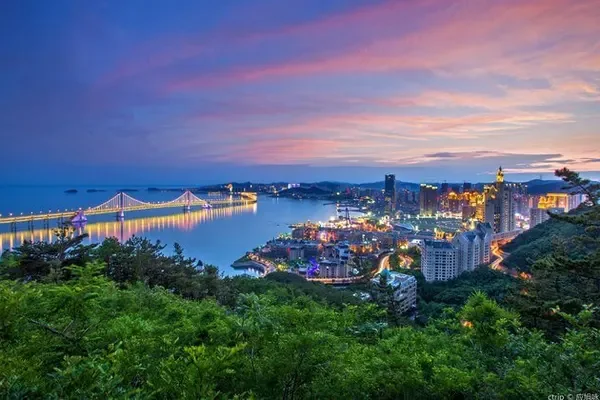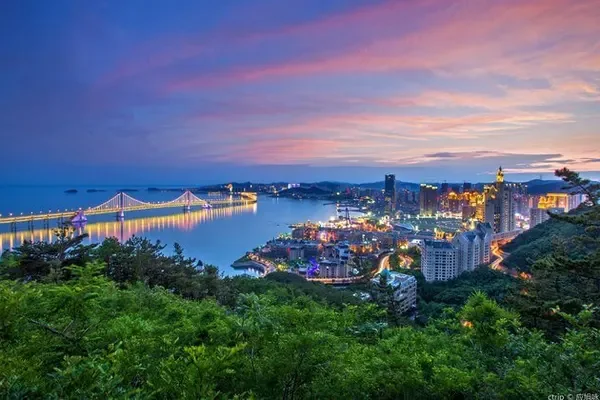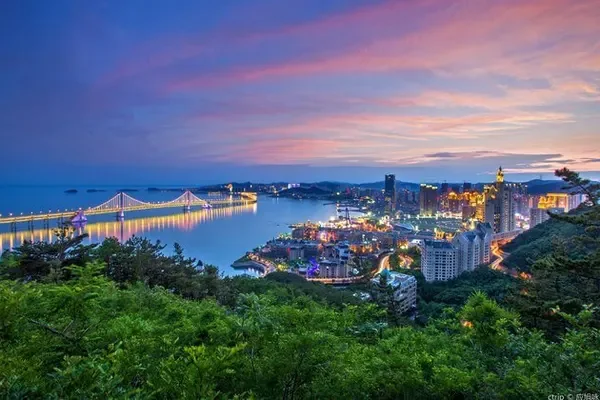The heavy snow season has just passed, and the weather is cold and windy. In the winter afternoon, I set foot on the "Auspicious Land for Thousands of Years" - Qing Dongling, 125 kilometers east of Beijing. How legendary and mysterious it is to visit this geomantic treasure land that Lord Shunzhi fell in love with at first sight. During the two and a half centuries, many people who had an important influence on the history of the Qing Dynasty were buried here. trampled and looted. When the prosperity is over, standing on this 247-year-old spring and autumn land, with admiration for the ancestors and exploration of history, slowly walk into it and understand it.
After paying homage, you can go to Zunhua Tangquan, 15 kilometers away, to take a refreshing hot spring bath, wash away the cold and fatigue, and enjoy the leisure of "give me a pool of hot spring water, and let it grow old and wild". Beautiful! Since the Tang Dynasty, this place has been the bathing place of the royal family of all dynasties, and has the reputation of "Jingdong's No. 1 Hot Spring". Emperors Shunzhi and Kangxi often came to bathe in the hot spring for leisure and health preservation.
Eastern Tombs of Qing Dynasty: Exquisite architecture comparable to the Forbidden City
The Eastern Tombs of the Qing Dynasty, this legendary royal cemetery, witnessed the rise and fall of the Qing Dynasty. It is the largest, most complete and well-organized imperial tomb complex in China.
When it comes to site selection, Feng Shui must be paid attention to when building royal mausoleums. Fengshui theory requires that a good auspicious area should be far away from Chaoshan Mountain, near Ananshan Mountain, and behind Zushan Mountain. Jinxing Mountain is exactly in a straight line, which is very in line with the auspicious omen of Fengshui. When Emperor Shunzhi came here to hunt, he climbed up and looked far away, and he fell in love with it at a glance. The mountains are beautiful, and he has the demeanor of a king. Since then, it has become the largest mausoleum area in the Qing Dynasty.
There are three gates at the southern end of the Eastern Tomb of the Qing Dynasty. The first road consists of two steep mountains facing each other, forming a natural mausoleum mouth. The second is a majestic stone archway, carved from white marble. The third way is the Dahongmen, which is a veritable gateway to the Eastern Tombs of the Qing Dynasty. Between the Dahongmen and the stone archway, there are horse cards in the east and west, and the front and back of the cards are engraved with "Officials wait to dismount here" in Manchurian and Chinese characters.
Many well-known figures are buried in the Eastern Tombs of the Qing Dynasty. The ancestor of the Qing Dynasty Shunzhi, the emperor Kangxi through the ages, the old man Qianlong, and the Empress Dowager Cixi who ruled the late Qing Dynasty for 48 years. There were 14 empresses including the politician Xiaozhuangwen, 136 concubines, 3 elder brothers, and 2 princesses, a total of 161 people.
Emperor Shunzhi’s Xiaoling Mausoleum is the largest in the Eastern Qing Dynasty, and it is also the only underground palace that has not been stolen. There are different opinions on the reasons, and 90% of them may be that there are not a lot of gold and jade funeral objects here, so the tomb robbers don’t want to bother. However, Kangxi's Jingling Mausoleum, Qianlong's Yuling Mausoleum, and Empress Dowager Cixi's Putuoyu Dingdong Mausoleum were not spared.
Emperor Qianlong’s Yuling Mausoleum is different. It was built during the heyday of the Qing Dynasty. It cost more than two million taels of silver and selected exquisite materials from all over the world. It is the same as Jingling, but the architectural technology and carving technology are the highest in Qingling.
Shi Xiangsheng is the general term for the stone man and stone beast set up on both sides of the Shinto in front of the tomb. After his death, Qin Shihuang made a bronze statue of him, which was used to scare the Huns from aggression, and later used to scare tomb robbers.
Along the stone bridge and stele pavilion, enter the mausoleum, and through the gate of the mausoleum, you can see five stone offerings, an incense burner, two vases, and two candlesticks. Then there are Minglou and Baoding. There is a cinnabar stele in Minglou. Opposite is Baoding, which is the tomb head.
On the Yudai River behind the Longen Hall and in front of the mausoleum. Single-hole arch coupon, three bridges side by side. White stone railings and dragon and phoenix column heads are installed on both sides of the bridge deck. The bridge is beautiful in shape, finely carved, small and exquisite. This kind of regulated stone bridge is the only example in Qingling.
Qianlong was born intelligent, and he achieved great success in both literary and martial arts. Reigning for 60 years, he is the emperor who has actually been in power for the longest time in Chinese history, and is also the most famous and longest-lived emperor. Walking into the Yuling Underground Palace, it is solemn and quiet. This underground palace with a depth of 54 meters has an area of 372 square meters. The beams and walls are covered with sculptures of Buddhist themes, including Buddha statues, ritual instruments, Buddha flowers, etc.; There are a large number of Tibetan and Sanskrit mantras, and the whole underground palace is like a solemn and beautiful underground Buddhist temple.
There are 4 white marble gates in the Yuling Underground Palace, with a total of 8 doors, each weighing 3 tons, with lifelike statues of Bodhisattvas carved on them. On the gate tower is a moonstone, and there are sculptures of various Sakyamuni statues, Sanskrit and other auspicious utensils. Emperor Qianlong, who believed in Buddhism, probably hoped that the Bodhisattva with boundless magic power could protect his dead souls from being violated and continue to enjoy prosperity and wealth in the underworld.
These exquisite carvings have smooth and delicate lines, rigorous and orderly layout; the Buddha statues are vivid and vivid, and the carving techniques are skillful and exquisite;
In the main hall, we also saw Qianlong's handwritten Zhang Yungu Dabao Zhenjuan, as well as the throne of Empress Xiaoyichun played by Wei Yingluo in "Story of Yanxi Palace".
Then came the Dingdong Mausoleum of Empress Dowager Cixi. Dingdong Tomb was built in the late Qing Dynasty and lasted for 14 years. Her three main halls are all built with the most precious huanghuali wood. On the ceiling, on the pillars, on the beam frame wood, and on the walls, the decorations are all resplendent and magnificent. According to records, more than 4,592 taels of gold were spent, which can be described as very luxurious. It is so luxurious that even the Hall of Supreme Harmony in the Forbidden City in Beijing cannot be compared.
Cixi is a famous "luxury" empress dowager in history. During her lifetime, she loved pearls, agate, gemstones, jade, gold and silver vessels and other treasures. After her death, the treasures buried in her coffin were worth as much as 100 million taels of silver. After that, Sun Dianying's bombing of the mausoleum and the robbery of treasures occurred, which shocked both at home and abroad. After seven days and seven nights of tragic destruction, it was in a mess, and a lot of gold, silver and jewels were lost to various places, which is very regrettable.
Speaking of the stone carvings of Cixi Mausoleum, it is also a must. The stone railings of "Phoenix leading the dragon to chase", the Danbi stone of "Phoenix above and the dragon below", and the pillars of "One phoenix pressing two dragons" can be described as outstanding stone carvings. Treasures, it can also be seen that Cixi's status was supreme at that time, so I was the only one in the world.
At present, the scenic spots open to the Eastern Tombs of the Qing Dynasty include Xiaoling Mausoleum Main God Road, Xiaoling Mausoleum, Jingling Mausoleum, Yuling Mausoleum, Dingdong Mausoleum, Yufei Garden Bed and Erlang Temple. If you have enough time, you can listen to the commentators explain these vivid and interesting historical story. The Eastern Tomb of the Qing Dynasty is the master of Chinese feudal imperial tombs. It can be said to be "a Qing Eastern Tomb, half of the history of the Qing Palace". After thousands of years, the Qing Eastern Tomb still exudes her unparalleled charm.
Zunhua Tangquan: Soak in a leisurely and hearty imperial soup
Soaking in hot spring is a fashion, especially in winter, it is the most suitable time to soak in hot spring, it nourishes and moisturizes the skin, and gives oneself a year-long tired body and mind a vacation. Say goodbye to the imperial mausoleum of the emperor, and move to Zunhua Tangquan Hot Spring, a blessed place with thousands of years of royal hot spring health preservation culture, follow in the footsteps of the two emperors Shunzhi and Kangxi, come here to live the life of an emperor for a day, soak in beauty Imperial Soup.
Zunhua Tangquan Hot Spring Resort is located in Tangquan Manchu Township, Zunhua City. It has a long history. It used to be a resort for countless emperors, ministers and literati to visit and treat diseases. There are many poems, endless historical stories and moving legends. Zunhua Tangquan Palace is a comprehensive resort. Unlike Japanese-style soup houses, the architecture of Tangquan Palace has its own characteristics. There are three major areas. The hotel includes an indoor hot spring area, and the outdoor hot spring area includes more than 20 various health pools and hillsides. Single-family villa area.
The whole hot spring scenic spot winds along the mountains, the hot springs are high and low, and hot air gushes out everywhere in the dense forests of the valleys, between the cliffs and on the ground. While enjoying the warm soup bath, you can enjoy the mountain scenery, breathe the clear air, and the surrounding steam is lingering, as if you are in a fairyland, quiet and pleasant.
Next to the soup pool are luxurious rooms and suites of different grades, as well as high-end suspended hot spring soup houses. Each soup house has a separate courtyard, with an exclusive suspended bubble pool inside, which is very private and convenient to enter and exit the soup pool.
In addition to the private soup house, there is also a 200-meter indoor public hot spring area, including a transparent hot spring pool, a bird's nest pool, a nine body health care area, a chestnut forest quiet area, a VIP pool area, a bird's nest pool, a children's paddling pool, and a dynamic There are a total of 50 characteristic bubble pools such as spa pools, as well as leisure and entertainment areas such as lounges and film and television halls.
The bubbling hot water gushes out from the surface, and the rising steam permeates the skin all over the body, quietly experiencing the joy of body and mind! Especially for beauties who love to soak in hot springs, a date with hot springs is perfect in this season!
After soaking in the hot springs, you can come to the steam room to sweat heartily, expel toxins from the body, eliminate fatigue, and have a good night's sleep. There are six steam rooms with different functions, such as loess, aromatherapy, and salt steam. You can sit or lie down, which is very user-friendly. It's the deep winter season, so it's best to find a warm place to take a dip and live a comfortable and slow life for a day.
【Practical Information】
1. Tombs of the Eastern Qing Dynasty
Address: Xiqing Dongling Tourist Service Center, Liupanying Village, Shimen Town, Zunhua City, Hebei Province
Off-season tickets for the Eastern Tombs of the Qing Dynasty (November 2018-March 31, 2019)
Price: 80 yuan ticket + 30 yuan traffic ticket; students and 60-year-olds are half-price 40 yuan ticket + 30 traffic ticket with their certificates
Open scenic spots: Xiaoling Mausoleum Zhushen Road, Xiaoling Mausoleum, Jingling Mausoleum, Yuling Mausoleum, Dingdong Mausoleum, Yufei Garden Bed and Erlang Temple.
Reference tour route: Tourists on this tour route can experience the magical feng shui of the Eastern Tombs of the Qing Dynasty, appreciate the beautiful picture scroll of harmony between nature and ancient buildings, perceive the traditional cultural concepts of seniority and order, and the distinction between superiority and inferiority, and explore the profoundness of ancient buildings. The vivid and interesting historical legends of the emperors and concubines Service base - Stone Archway - Dahongmen - Dabeilou - Stone Statues - Dragon and Phoenix Gate - Yuling - Cixi Mausoleum - Concubine Yu - Xiaoling Mausoleum ——Jingling——Service Base
Traffic routes:
1. Direction to Beijing
Beijing Airport Expressway—Jingping Expressway—Pingji Expressway—Jixian Exit—Jixian North Outer Ring Road—Mashen Bridge—turn left at Shimen—Qing Dongling. Beijing—Beijing-Shenyang Expressway—Baodi (the road section has road signs) turn to Jinji Expressway—exit at Jixian Exit—Mashen Bridge—turn left at Shimen—Qing Dongling.
2. Tianjin direction
Tianjin—Jinji Expressway—Jixian Exit—Jixian Beiwai
3. Northeast direction
Qinhuangdao—Beijing-Shenyang Expressway—Tangcheng Expressway (Zunhua southbound)—Zunhua West Outer Ring Road—turn right at Shimen—Eastern Tomb of Qing Dynasty.
4. Chengde direction
Tangcheng Expressway - Zunhua southward - Qing Dongling direction.
2. Zunhua Tangquan
Zunhua Tangquan Hot Spring Resort is located in Tangquan Township, Zunhua City, covering an area of 12.4 square kilometers. Because the spring water boils like soup in four seasons, it is called "Tangquan". It has one of the eight sceneries of Dongling in the past - a hot spring bath day. Surrounded by mountains and rivers, magnificent palaces, beautiful scenery and charming scenery, it is a well-known tourist attraction at home and abroad.
Address: Tangquangong Hot Spring Resort, Tangquan Township, Zunhua, Tangshan City, Hebei Province
Room type: standard hotel room, deluxe double bed room, outdoor hot spring soup house
Price: ranging from 448-1979 yuan
Note: Accommodation includes breakfast, you can also buy hot spring package directly online



